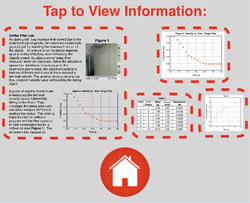About Coffee Filter Physics Lab
 Highly Recommended
Highly Recommended
Like all our Science Reasoning Center activities, the completion of the Coffee Filter Physics Lab activity requires that a student use provided information about a phenomenon, experiment, or data presentation to answer questions. This information is accessible by tapping on the small thumbnails found on the bottom right of every question. However, it may be considerably easier to have a printed copy of this information or to display the information in a separate browser window. You can access this information from
this page.
The Standards
The Coffee Filter Physics Lab activity presents students with information regarding a lab investigation related to air resistance and terminal velocity. The activity requires that students make meaning of written information, select and interpret data presented in graphs and tables, and identify conclusions that are consistent with experimental findings. Success with the activity requires some degree of understanding or proficiency with respect to ...
- Analyzing and Interpreting Data (Science and Engineering Practice 4.1)
Analyze data using tools, technologies, and/or models (e.g., computational, mathematical) in order to make valid and reliable scientific claims.
- Developing and Using Models (Science and Engineering Practice 2.3)
Develop, revise, and/or use a model based on evidence to illustrate and/or predict the relationships between systems or between components of a system.
- Patterns (Crosscutting Concept 1.1)
Different patterns may be observed at each of the scales at which a system is studied and can provide evidence for causality in explanations of phenomena.
- Stability and Change (Crosscutting Concept 7.1)
Much of science deals with constructing explanations of how things change and how they remain stable.
While the Coffee Filter Physics Lab activity addresses the two NextGen Science and Engineering Practices and two Crosscutting Concepts above, the activity drew its greatest inspiration from
ACT's College Readiness Standards for Science Reasoning. The activity consists of 76 questions organized into 20 Question Groups and spread across the five activities. All three strands (Interpretation of Data - IOD; Science Investigation - SIN; and Evaluation of Models, Inferences, and Experimental Results - EMI) of the College Readiness Standards are addressed in this activity. The code given for the standard includes three letters to indicate the strand and three numbers to indicate the specific standard within that strand. Higher numbers are indicative of more complex science reasoning skills. The relationship between the questions and the standards is as follows:
Complementary and Similar Resources
The following resources at The Physics Classroom website complement the Coffee Filter Physics Lab Science Reasoning Activity. Teachers may find them useful for supporting students and/or as components of lesson plans and unit plans.
The Physics Classroom Tutorial, Newton's Laws: Free Fall and Air Resistance
Physics Video Tutorial, Newton's Laws: Air Resistance, Terminal Velocity, and Skydiving
Physics Interactives, Newton's Laws: Skydiving Simulation
Physics Interactives, Newton's Laws: Falling Bodies 1D
Concept Builders, Newton's Laws of Motion: Air Resistance and Skydiving
Minds On Physics, Newton's Laws Module: Mission NL11, Air Resistance